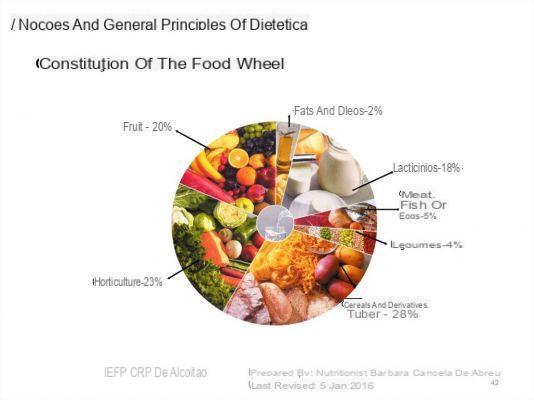
Every living being is made up of billions of cells. Health is maintained thanks to food, which provides our body with all the food principles necessary for:
-
have theenergy to preserve its vital functions and activities
-
build and renovate all its cells and tissues
-
adjust and maintain its reactions, its metabolism
Through the metabolism the body derives from food the energy necessary to perform all vital functions (breathing, moving, making the heart beat ...). The unit of measurement ofenergy are the kilocalories (or a thousand calories, with the Kcal symbol). A calorie è the amount of heat needed to pass 1 liter of water from 19 to 20 degrees.
All the food principles provided by foods can be divided into large ones category: macro and micro-nutrients.
Macronutrient food principles: sugars or carbohydrates (carbohydrates, glycides, saccharides)
There are simple (present in common sugar, milk, honey) e complex (present in bread, pasta, rice, potatoes, corn). They make up the fuel for our muscles, they are quickly available and provide approx 4 kcal per gram. They possess numerous essential biological functions.
The main deposits of carbohydrates in our body are in the liver in the muscles. The reserve of carbohydrates in our body is limited to approximately 2000 KcaL. When these reserves are exhausted - after 24 hours of fasting or intense activity - the glucose necessary to live is synthesized from muscle proteins.
About the 55-60% of your daily calories should come from complex carbohydrates.
Macronutrient food principles: fats (lipids)
It is a large family of substances. Based on the chemical bonds within them, they are broken down into fats saturated (solid at room temperature, such as butter) and fat unsaturated (liquids at room temperature, such as oil). I'm an important one energy reserve: each gram of fat provides 9 kcalories. They are used in the formation of the membranes that surround cells, they are precursors of many hormones and of provitamin D. Adipose tissue represents the main backup energy source for our organism and forms a layer insulating and protection mechanics of internal organs.
In the daily diet, fats should not exceed the 20-30% of the total intake and it is preferable to consume polyunsaturated vegetable oils, which provide "good" vitamins and fats.
There is a group of aessential unsaturated fatty acids, which the body cannot produce itself and must be taken with the diet: linoleic acid (omega 6), linolenic acid (omega 3) and acid arachidonic (omega 6), are also constituents of cell membranes; they regulate the maintenance of blood vessels and the efficiency of the nervous system. They are called "Vitamin F" and are found in various vegetable oils, fish fat, oil seeds, dried fruit.
Macronutrient food principles: proteins (proteins)
They are the food principles present in the foods of animal origin (meat, milk, eggs, fish) e vegetable (soy, wheat gluten, legumes). They form muscles, hormones and the immune system, they are receptors on cell membranes. They are formed by chains composed of 20 different units called amino acids, of which nine are essential as the body does not produce them and must be consumed in the diet. An excessively protein diet is dangerous to health. In fact, the waste products of protein metabolism are toxic for the body. One gram of protein provides 4 calories. About the 15-20% of daily calories should be of protein origin, approximately one gram for each pound of body weight.
Food principles micronutrients: vitamins, minerals and water
No contributioncalorie year and they need it small quantities, but they are very important regulators of vital functions. With the exception of vitamin D alone (which can be produced by the body through exposure to the sun), all non-caloric food principles are essential, that is, they must be introduced with food as the body is unable to produce them.
Vitamins: they intervene in the mechanisms of growth, blood coagulation, vision, iron absorption, prevention of aging processes and some diseases. They are divided into two groups: - water-soluble (water soluble), easily absorbed by the intestine and eliminated, if in excess, through the urine. They are Vitamins C, B1, B2, B6, B12, PP, H, F, pantothenic acid, folic acid. - liposolubili (soluble in fats), absorbed in the intestine together with fats and then accumulated in the liver and adipose tissue in considerable quantities (with the risk of overdosing). They are hardly alterable to temperature variations but sensitive to oxygen. They are Vitamins A, D, E, K.
And minerals: trace elements, contribute to the formation of bones and teeth, are activators of metabolic reactions and keep constant theinternal and external environment to the cells. In humans, they represent about 6% of body weight. Many mineral salts are related to each other: the excess of one limits theabsorption of the other or perform opposite actions. Even if present in small quantities, they are essential for health. Examples of mineral salts: sodium (Na), chlorine (Cl), potassium (K), calcium (Ca), phosphorus (P), magnesium (Mg), iron (Fe), zinc (Zn), iodine (I).
Water (H2O): represents about 60% of the weight body in the adult and performs various functions in the balance of the organism, in the metabolism, in the circulation. The amount of water produced by the metabolism is not sufficient to cover the daily requirement. Under normal conditions the daily change of water corresponds to 15% of body weight in the first months of life and about 10% in adults.
To distinguish the different food principles present in foods, you have to pay attention to the labels.
| NutritionEducation


























